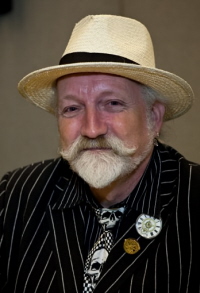Occasional Mentions of Brentford in Literature
First up has to be Robert Rankin
|
Robert Rankin’s ‘Brentford Trilogy’ is the most famous example of Brentford in literature. Rankin, himself, grew up in Brentford and bases his novels on the town.
Despite it being called a trilogy the series now comprises eight novels: The Antipope (1981), The Brentford Triangle (1982), East of Ealing (1984), The Sprouts of Wrath (1988), The Brentford Chainstore Massacre (1997), Sex and Drugs and Sausage Rolls (2000), Knees Up Mother Earth (2004), The Brightonomicon (2005).
The Flying Swan is the local pub for the main characters of Rankin’s books and is based on the Bricklayers Arms.
The Bricklayers Arms was frequented on match-days by Brentford fans and was a very popular haunt for the fans until it closed in 2007.
According to 'Beer in the Evening', Rankin used to sit in the corner of the pub taking notes on what went on.
No one took much notice until The Antipope was published, then more than a few people recognised themselves.
The Flying Swan appears in the opening of The Brentford Triangle where “Neville the part-time barman drew back the polished brass bolts and swung open the saloon-bar door of the Flying Swan.” (page 1)
Gunnersbury Park is also mentioned in Rankin’s book Sex and Drugs and Sausage Rolls.
The park was opened to the public by Neville Chamberlain in 1926 and is controlled by both the London Borough of Ealing and the London Borough of Hounslow.
Access to Gunnersbury Park was made more difficult with the building of the M4 flyover in the 1960s.
The elevated section extends over parts of Brentford’s Golden Mile, called this due to the varying industries concentrated within this section of the Great West Road.
The park was an area for business in Sex and Drugs and Sausage Rolls where it was suggested by John that Jim goes to Gunnersbury Park. (page 237).
The 65 bus features in The Brentford Chainstore Massacre. The 65 bus route travels from Ealing to Kingston/Chessington through Brentford.
It is a route that stops on the Ealing Road opposite Griffin Park and also close to the Albany pub.
John “steps down from the 65 and stood on the corner outside Norman’s paper shop.” (page 100).
The paper shop on the corner of Albany Road is where the Coral bookmakers is today.
The Brentford Mercury appears to be based on the local newspaper Hounslow and Brentford Times, which is about to fold after 100 years of service.
In East of Ealing Norman “always wanted to shake the hand of the editor of the Brentford Mercury who had run off with his wife” (page 204).
These areas around Brentford have been featured in Rankin’s works and demonstrates how Brentford, the place he has spent a large part of his life, has been a major influence on Rankin’s books.
Although Robert Rankin moved to Brighton some years ago, he still visits regularly.
His fan club Sproutlore bought their very own bench outside Brentford library (read the books to find out why).
A fan said: “Rankin's work is a place of unexpected treasures. Reading his work is much like being in the hands of a drunken father, very safe and yet prone to unpredicted bumps and tosses along the way.
“He does not follow the rules as adventure does not follow the rules.
“To quote his work: "This is not the way things are done in Boy’s Own Adventure books.
“I recall no mentions of homosexual gang-rape and cannibalism”
Robert last visited to join in our St George's Day celebration in Market Square.
Tom Moore
If you would like to contribute to this series of articles looking at Brentford in Literature, or write book reviews, please contact the editor
December 22, 2010
